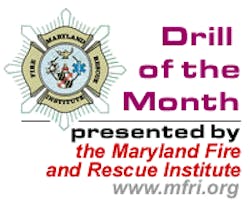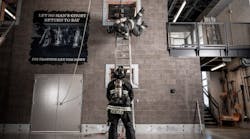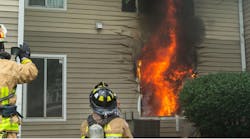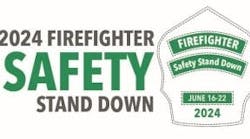Firefighter Review
Session Reference: 3
Topic: Attack Line Handling
Level of Instruction:
Time Required: Three Hours
Materials:
• Two Fully Equipped Pumpers
• Structure for Use in Advancing Hose
References:
• Engine Company Fireground Operations, Second Edition, NFPA, Pages 2-6, and Chapters 4 and
6-11
• Essentials of Fire Fighting, Fourth Edition, IFSTA, Chapters 12 and 13
PREPARATION:
Motivation:
Objective (SPO):
The firefighter will demonstrate a general understanding of the construction, operation, and utilization of fog and solid stream nozzles and, by participation and observation, a knowledge of the various nozzles, hose layouts, appliances, and procedures involved in applying water at a structural fire.
Overview:
Attack Line Handling
• Handlines and master streams
• Built-in fire protection system components
• Hose and nozzle selection
• Hose stream placement
• Supporting built-in fire protection systems
Session 3 Attack Line Handling
SPO The firefighter will demonstrate a general understanding of the construction, operation, and utilization of fog and solid stream nozzles and, by participation and observation, a knowledge of the various nozzles, hose layouts, appliances, and procedures involved in applying water at a structural fire.
EO 3-1 Describe the appropriate number, size, and placement of fire streams needed to deliver the required fire flow at structural fires.
EO 3-2 Describe the engine company responsibility for supporting built-in fire protection systems.
EO 3-3 Demonstrate various sizes of hose and different nozzles used to produce streams for fire attack.
EO 3-4 Demonstrate the placement of fire streams at structural fires.
EO 3-5 Demonstrate the utilization of the engine company to support built-in fire protection systems.
I . Handlines And Master Streams (3-1)
NOTE: Some material may be a review since handline operation and setting up master stream devices are included in Firefighter I. Focus should be more on handline and master stream selection and application in fire situations.
A. Hose Line Selection
1. Engine company must be considerate of limitations of various sizes of hose
2. In addition to flow limitation, there is factor known as friction loss which affects fire flows
a. Loss of pressure within hose line due to internal resistance of water against hose lining
b. Friction loss affected by three factors
1) Flow
2) Hose length
3) Size of hose
c. Should be consideration to engine company crew when selecting attack lines which must be
stretched over long distances
3. Maximum flow capabilities for attack lines
1-1/2-inch 125 gpm
1-3/4-inch 150 gpm
2-inch 200 gpm
2-1/2-inch 250 gpm
3-inch 400 gpm
4. Range of nozzle flows for combination nozzles with recommended nozzle pressure of 100 psi
1-1/2-inch 30 gpm to 125 gpm
1-3/4-inch/2-inch 95 gpm to 200 gpm
2-1/2-inch 125 gpm to 250 gpm
5. Flows for a 2-1/2-inch straight tip nozzle with recommended nozzle pressure of 50 psi
1-inch tip 210 gpm
1-1/8-inch tip 266 gpm
1-1/4-inch tip 328 gpm
6. Flows from master stream devices
a. Fog nozzle minimum is 500 gpm at 100 psi nozzle pressure
b. Flows for straight tips with recommended nozzle pressure of 80 psi (rounded)
1-1/2-inch 600 gpm
1-5/8-inch 700 gpm
1-3/4-inch 800 gpm
1-7/8-inch 900 gpm
2-inch 1000 gpm
7. Friction loss for attack lines
a. For 1-1/2-inch, 1-3/4-inch, and 2-inch attack lines, 30 psi per hundred feet
b. For 2-1/2-inch attack lines, 15 psi per hundred feet
c. 1-1/2-inch, 1-3/4-inch, and 2-inch attack lines should not exceed 300 feet in length
d. 2-1/2-inch attack lines should not exceed 500 feet
e. When lengths of attack line beyond those recommended are required, consideration should be
given to using 3-inch, 4-inch, or 5-inch hose to get water closer to the fire scene and dividing the
flow into more manageable size attack lines using wyes or manifolds
B. Initial Attack
1. Indirect attack - fog stream used to attack fire from outside building
a. Should not be used to fight fire in occupied building
b. Quick interior attack should not be made in building undergoing demolition, abandoned, had
previous fires or under construction
c. If large intense fire encountered, may be necessary to knock down or control fire from outside
using solid stream before making interior attack
2. Solid streams versus fog streams
a. For safest and most effective operation where people in area, solid stream or fog nozzle on solid
stream position should be used
1) Aid rescue
2) Reduce steam production
b. Use of fog should be restricted to unoccupied confined spaces
c. When building adequately ventilated opposite direction from fog nozzle, fog stream can be used
1) No more than 30-degree angle
2) Produces reach and fog pattern
3. Effective stream operation
a. Use solid stream nozzles or set fog nozzles on solid stream setting
b. Stay low upon entering fire area to let heat and gases vent before moving in
c. Before door to fire area opened, all firefighters should be positioned on same side of entrance
and remain low
d. Crack nozzle and bleed air out of line ahead of water
e. If fire shows at top of door as opened, ceiling should be hit with solid stream to cool and control
fire gases
f. Sweep floor with stream to cool burning debris and hot surfaces
g. Do not open stream until fire can be hit unless firefighter safety involved
h. Direct stream at base of fire if localized
i. As advance made, angle of stream should be lowered and attempt made to hit main body of fire
j. When main body of fire knocked down, shut down stream and let area to vent
k. When fire knocked down, shut down
l. Upon entering area which is very hot and finding no fire, withdraw immediately and check area
below
m. When attacking basement fire down interior stairs, solid stream should be used because fog will
generate steam
4. Number of lines
a. Attack main body of fire
b. Get over fire
c. On each side of fire
d. Consideration must be given to mobility of hose and flow requirements
C. Back-Up Lines
1. Purpose of back-up lines
a. Used when initial attack lines cannot quickly control fire
b. Not used to protect exposures or attack fire
c. Held in readiness for use in place of attack lines
d. May also be used for back-up or safety team
2. Stretched whenever not completely obvious that fire quickly extinguished with initial attack lines
a. Taken into building immediately after initial attack lines
b. Positioned close to initial attack lines
c. Charged and ready for use
3. Size of back-up lines
a. For 1-1/2-inch lines, minimum 1-3/4-inch
b. For 1-3/4-inch lines, minimum 2-1/2-inch
c. For 2-1/2-inch lines, minimum 2-1/2-inch with larger tip
d. For fire where initial attack is 2-1/2-inch line, master stream devices may be required
4. If back-up lines placed in service, initial attack lines should be shut down
5. Once fire controlled, back-up lines shut down and smaller line used for mop up
6. On any working fire, a back-up or safety team should be standing by with charged line and ready
to make entry should the initial attack crew require assistance
D. Master Stream Devices
1. Water supply for master streams
a. Pumper at water source sending water to pumper at fire
b. Adequate number of supply lines laid between pumpers and from pumper at fire to master
stream device
c. No more than 100 feet of hose between pumper at fire and master stream device
2. Use of master stream devices
a. Fire attack
b. Back-up
c. Exposure protection
3. Solid stream versus fog stream
a. Solid stream most effective
1) Wind conditions
2) Strong draft created by large fire
3) Distance from nozzle to building
b. Fog streams superior
1) Exposure protection
2) Covers wider area
4. Positioning device
a. Fog nozzle must be positioned close to structure
b. Solid stream functions better if positioned some distance from building
5. Directing heavy streams
a. Move horizontally back and forth across fire area
b. Move up and down to reach full depth
c. Look to see if water is entering building or hitting building
II . Built-In Fire Protection Systems (3-2)
A. Standpipe Systems
1. Piping arrangement that carries water vertically and horizontally through building for firefighting
operations
2. Two types of systems
a. Dry system - not connected to water supply
1) Interior system has at least one outlet on each floor
2) Exterior system usually runs along fire escape
3) May include multiple interconnected systems
b. Wet system - connected to one or more sources of water
1) Minimum flow of 250 gpm at residual pressure of 65 psi on roof or
2) Minimum pressure of 40 psi on 1-1/8-inch tip connected to 100 feet of 2-1/2-inch hose
attached to highest outlet with nozzle on roof
3) May include multiple separate or interconnected risers
3. Fire department siamese
a. Water should be pumped into any standpipe system being used for firefighting
b. At least two lines should be connected
1) First line to left intake and charged
2) Second line to right intake
c. If supply line cannot be connected to siamese, water can be supplied to system through outlet
on first floor
d. Pumper should be positioned within 50 feet
4. Fire attack from standpipe systems
a. Equipment
1) 150 feet of 1-1/2-inch or 1-3/4-inch hose
2) Nozzle
3) Gated wye
4) Pipe wrench in the event the hand wheel on outlet missing
5) Secondary standpipe pack consisting of 2-inch or 2-1/2-inch hose
6) Short section (5 feet) of 2-1/2-inch or 3-inch hose to go between outlet and gated wye
7) Gated wye may be equipped with 1-1/2-inch to 2-1/2-inch increaser to permit connection of
larger attack hose
b. Beginning attack operations
1) Connect to outlet in stairwell on fire floor (Firefighter I teaches to connect on floor below fire
floor)
2) Pull excess hose up stairway toward next floor before charging
3) If outlet in corridor, connect on floor below fire floor
4) Be careful not to impede evacuation or allow great volumes of smoke in stairway
B. Automatic Sprinkler Systems
1. Types of systems
a. Wet system - piping completely filled with water from source to heads
b. Dry system - system contains water only from source to control valve
c. Pre-action system - dry system with air exhausters controlled by heat detectors
d. Deluge system - designed to deliver large volume of water; water only from source to control
valve
2. Water supply
a. Can be supplied by gravity tank, pressure tank, fire pump, or water main
b. Engine company should attach two lines to siamese and prepare to pump system
III. Hose and Nozzle Selection (3-3)
A. During the evolutions below, the students will demonstrate their proficiency in the handling and use of various hoses and nozzles used to control and extinguish a fire.
B. The nozzles will first be reviewed by the instructor. All water will be discharged outside the structure.
C. The student should already be familiar with the appliances required and the techniques involved in the evolutions. What is being emphasized here is teamwork and operating efficiency.
IV. Hose Stream Placement (3-4)
A. The student will perform the following evolutions:
1. Advance an uncharged 1-1/2-inch, 1-3/4-inch, or 2-inch line up an interior stairs to a location
above the ground floor.
2. Advance a charged 1-1/2-inch, 1-3/4-inch, or 2-inch line up an interior stairs to a location above
the ground floor.
3. Advance a charged 1-1/2-inch, 1-3/4-inch, or 2-inch line down an interior stairs to a location
below the entry floor.
4. Advance an uncharged 1-1/2-inch, 1-3/4-inch, or 2-inch line up a ladder to a floor above the
ground floor.
5. Advance a charged 1-1/2-inch, 1-3/4-inch, or 2-inch line up a ladder to a floor above the ground
floor.
6. Advance a charged 1-1/2-inch, 1-3/4-inch, or 2-inch line to the fire floor and a second charged
line of the same size to the floor above the fire floor.
7. Advance a charged 2-1/2-inch line up an interior stairs to a location above the ground floor.
8. Advance a charged 2-1/2-inch line up a ladder to a floor above the ground floor.
9. Advance a charged 1-1/2-inch, 1-3/4-inch, or 2-inch line to the fire floor and a 2-1/2-inch charged
line to the floor above the fire floor.
10. Advance an uncharged 1-1/2-inch, 1-3/4-inch, or 2-inch line to the floor below the fire floor,
connect it to the standpipe connection, charge it, and advance it to the fire floor. After charged,
extend the line to a higher floor.
11. Advanced an uncharged 3-inch, 4-inch, or 5-inch line to the base of a structure, attach a wye,
connect two 1-1/2-inch, 1-3/4-inch, or 2-inch lines, charge the system, and advance the attack
lines into the structure.
12. Set up, advance lines, and charge a portable master stream device.
B. The evolutions will first be reviewed by the instructor before being run with moving apparatus. All water will be discharged so a not to damage any structures or surroundings.
C. These evolutions are designed to expose the student to various methods of applying water at the fire scene. The student should already be familiar with the appliances required and the techniques involved in the evolutions. What is being emphasized here is teamwork and operating efficiency.
V . Supporting Built-In Fire Protection Systems (3-5)
A. Set up and establish a water supply from the attack pumper to a fire protective system using multiple lines of 2-1/2-inch or 3-inch hose.
B. The evolution will first be reviewed by the instructor before being run with moving apparatus. This evolution can be conducted in conjunction with Evolution No. 7 above.
C. The evolution is designed to expose the student to the method of supporting built-in fire protection systems at the fire scene. The student should already be familiar with the appliances required and the techniques involved in the evolution. What is being emphasized here is teamwork and operating efficiency.
SUMMARY:
Review:
Attack Line Handling
• Handlines and master streams
• Built-in fire protection system components
• Hose and nozzle selection
• Hose stream placement
• Supporting built-in fire protection systems






